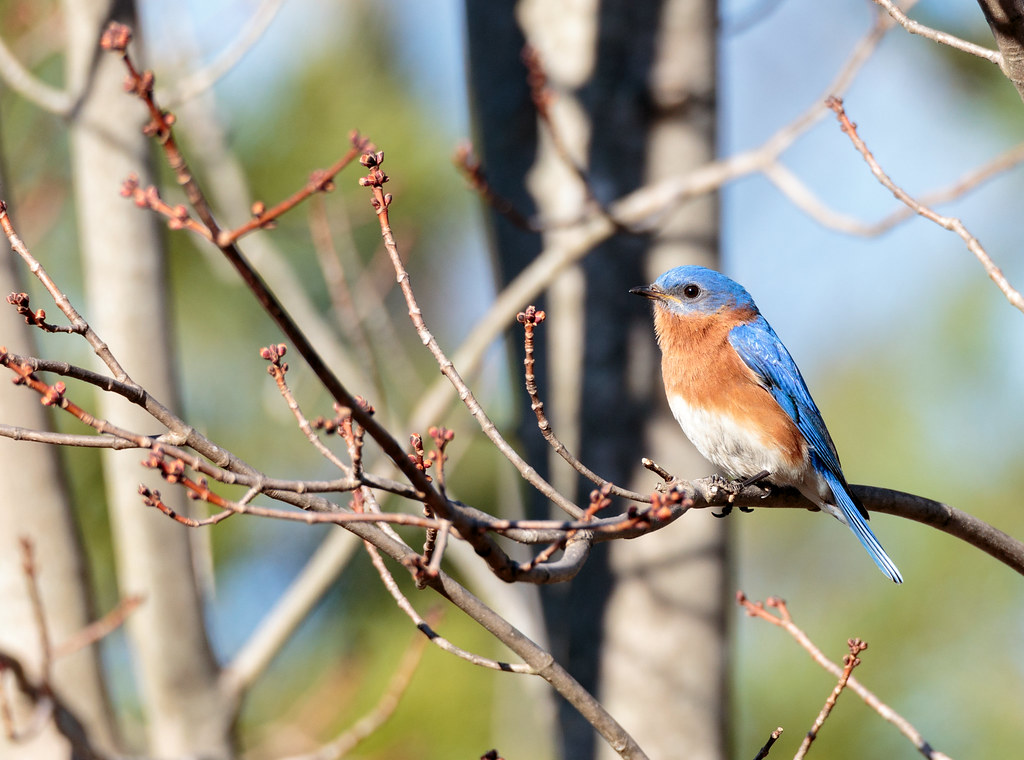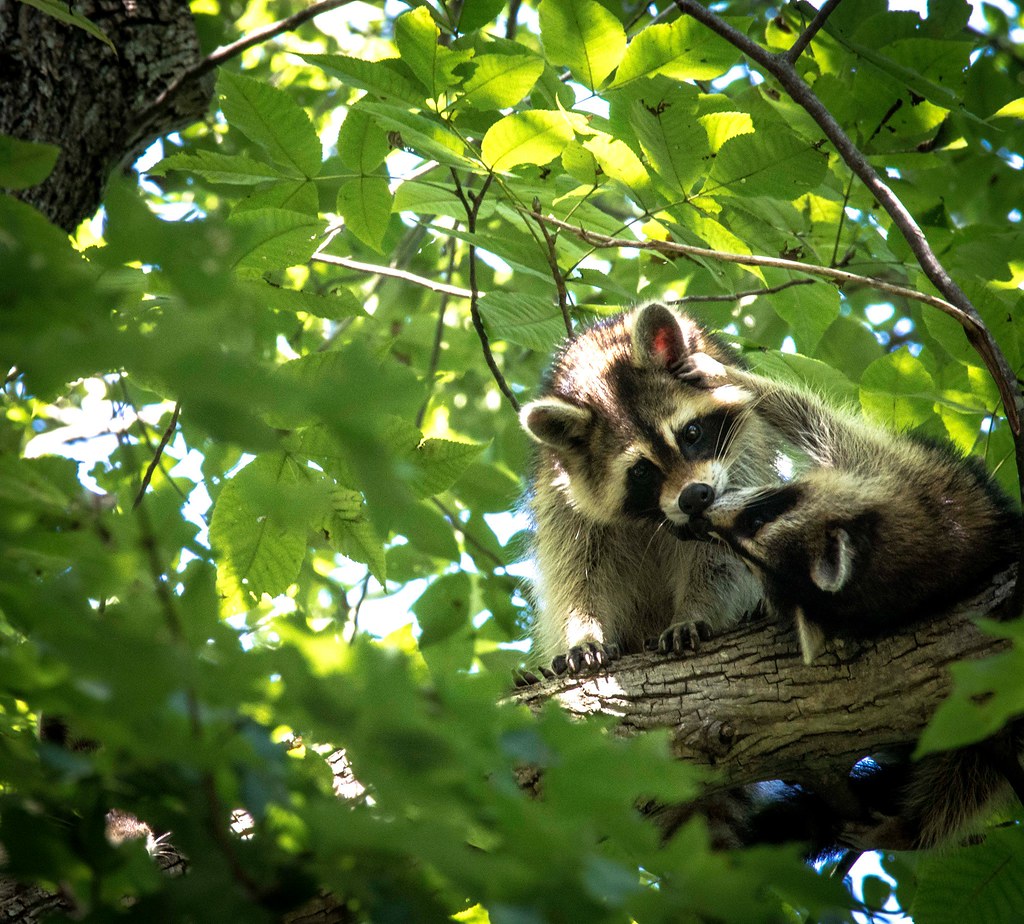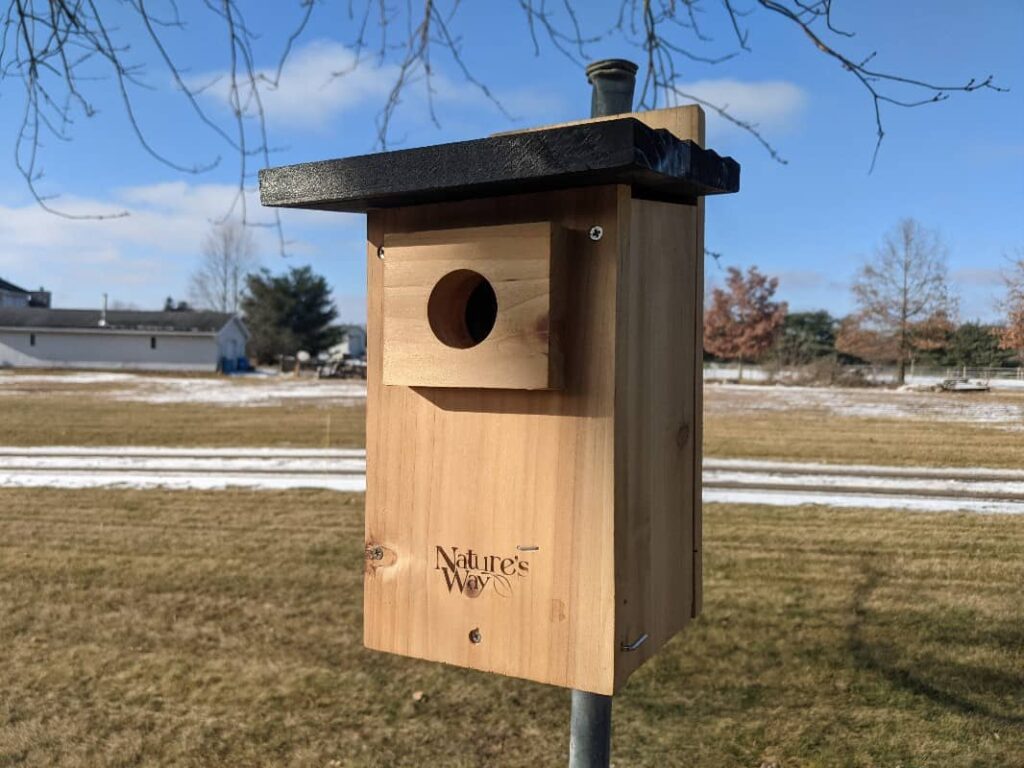
Putting up a bluebird house might seem relatively simple to the average person. Don’t you just buy a cute bird house at the store and nail it to the nearest wooden post or tree? After doing some research, you will find that bluebirds are a little bit picky when it comes to what kind of nest box they prefer and where they choose to nest. Bluebirds also have quite a few predators that are on the lookout for their nest boxes. So, the question of where to set up a bluebird house is a very important one. I have been working to attract bluebirds for almost 20 years, so I have some answers for you. Today’s question that I will be answering is this: Can I put a bluebird house on a tree?
As a general rule, you can put a bluebird house on a tree, but this is not recommended because it often attracts climbing predators. Raccoons, cats, and snakes (which all eat bluebirds) can easily access nest boxes that are nailed to trees. Mounting a bluebird house to a metal pole is a much safer option.
The Problem with Tree-Mounted Nest Boxes
So, why is it wrong to nail a nest box to a tree? Don’t bluebirds normally build their nests in old woodpecker holes…which are in trees?

Unfortunately, the risk of predators finding a nest in a tree are very high, even for bluebirds that nest in natural woodpecker holes. When you put up your own bluebird house, the last thing that you want is for a raccoon or other predator to find it and destroy the nest.
In this article, I will give you three compelling reasons that you shouldn’t put a bluebird house on a tree. I will also explain the safest alternative that you should be using (it’s a metal pole, by the way).
3 Reasons You Shouldn’t Put Bluebird Nest Boxes on Trees
1. Raccoons Can Climb Trees Easily

Raccoons are one of the bluebirds’ top climbing predators, and they would love nothing more than to find a bluebird house nailed to a tree. Tree-mounted nest boxes provide raccoons with easy-access to an almost guaranteed meal. They will climb the tree, reach inside the nest box entrance hole, and pull eggs, nestlings, and even adult bluebirds right out of the nest box.
Some people go years without having raccoons find their bluebird houses, but once they finally do, raccoons are relentless. They will target your bluebirds with no mercy. The best course of action is to move any bluebird houses you have off of a tree and onto a mount that is not as easy to climb. We’ll talk about the metal pole option later.
2. House Cats Love to Find Nest Boxes in Trees

If your bluebird house is nailed to the trunk of a tree, it becomes an easy target for house cats. Domestic cats are actually a common bluebird predator, even though they are not a wild animal. When house cats are free to live outside, as many are, they often find bird nests and attempt to make them into a meal!
This is especially true with bluebirds, since bluebirds have a very defined and obvious nesting location (a nest box).
Moving your nest box from a tree to a thin metal pole won’t completely solve the house cat problem, but it will make it a lot better. Of course, cats can jump on top of a bird house that is on a metal pole (they don’t need to climb). However, cats prefer the stealthy approach. A tree trunk allows a cat to crouch just below the entrance hole of the nest box and surprise bluebirds and/or reach into the nest. When the nest box is on a metal pole they have a much harder time.
Plus, a metal pole forces cats to sit on top of the nest box. This gives you more of a chance to shoo the cats away or put them inside where they are no longer a danger to your bluebirds.
Recommended Reading: 10 Steps to Become a Bluebird Landlord
3. Trees Can Attract Snakes, Mice, and Squirrels
Snakes, mice, and squirrels are also attracted to tree-mounted nest boxes. These animals might not seem like an immediate threat to bluebirds, but they can do more damage that you’d think.
Squirrels and mice will seek to use the nest box for themselves, and in doing so, often kill bluebird nestlings and adults.
Rat snakes, a very common predator, love to climb trees and wooden poles and devour entire nests of bluebirds. They fit perfectly through the entrance hole and you might even be surprised to find one when you open up the nest box!
Avoid this nightmare by setting up your bluebird house from the get-go on a metal mole. You shouldn’t put bluebird nest boxes on trees.
Solution: Set Up Your Nest Box on a Metal Pole

Instead of nailing your bluebird nest box to a tree, you should mount it on top of a metal pole. Metal poles are more difficult for raccoons and cats to climb, and they are better at keeping snakes, mice, squirrels and other predators away from the nest box.
You can use any thin metal pole, as long as you can fasten the nest box to the top of the pole. The North American Bluebird Society recommends using a “1/2 to 3/4 inch electrical metal conduit (EMT), or a T-post with 1.5 inch EMT on top.”
Here is a link to a 1/2 inch electric metallic tube (EMT) conduit from Home Depot. This 10-foot pole is long enough to go into the ground and leave 5-6 feet of pole above ground for mounting the nest box at eye level. The nest box can be fixed to the pole at eye level with a two-hole strap and two screws. Here’s a link to a two-hole strap you can get from Home Depot.
For a few extra bucks you can purchase a universal mounting pole kit that is designed specifically for bluebird houses. Many Bluebird Landlord readers have purchased this one from Amazon.

